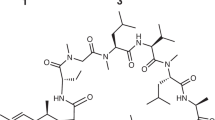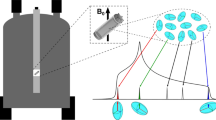Abstract
The use of varying multiple-pulse decoupling cycle times in homonuclear dipolar decoupling experiments with combined rotation and multipole-pulse spectroscopy proton nuclear magnetic resonance (NMR) is shown to be capable of quantitatively and qualitatively analyzing amounts of occluded residual liquid solvent, present as saturated solution, in some organic solids crystallized from solution. Lower limits of detection can be 0.01 mol%, as illustrated for the cases of durene,p-hydroxy benzoic acid, and adipic acid crystallized from ethanol, and alanine crystallized from water. Quantitative detection at this level depends upon the phase diagram of the system in question, and the ability to obtain a high-resolution proton NMR spectrum from that portion of the sample consisting of the occluded solvent impurity in the presence of a relatively large proton background from the probe. Determinations of spin diffusion may be used to infer the average size of the mobile domains containing the impurity. The variation of longitudinal relaxation time with temperature may be used as a check on the uniformity of saturated solvent occluded in the system studied. The classical case of using a cooling curve to detect the total amount of liquid protion remaining in the crystal after crystallization is discussed.
Similar content being viewed by others
References
Gerstein B.C., Hu J.Z., Ye C., Solum M., Pugmire R., Grant D.M.: Solid State NMR6, 63–72 (1996)
Ding S., McDowell C.A.: J. Magn. Reson. A111, 212–214 (1994); Ding S., McDowell C.A.: J. Magn. Reson. A115, 141–144 (1995)
Ding, S., McDowell C.A.: J. Magn. Reson.120, 261–263 (1996)
Ding, S., McDowell C.A.: J. Phys. Condens. Matter11, L199-L204 (1999)
Gerstein B.C., Kimura H.: Magn. Reson. Chem.39, 630–632 (2001)
Taylor R.E., Pembleton R.G., Ryan L.M., Gerstein B.C.: J. Chem. Phys.66, 361–361 (1977)
Ripmeester J.: Mol. Cryst. Liq. Cryst.64, 133–138 (1981)
Lee M., Goldburg W.I.: Phys. Rev.140, 1261–1271 (1965)
Gerstein B.C. in: High Resolution NMR Spectroscopy of Synthetic Polymers in Bulk (Komoroski R., ed.), chapt. 9. New York: VCH Publishers Inc. 1986.
Gerstein B.C., Dubowski C.R.: Transient Techniques in NMR of Solids, chapt. 5. New York: Wiley 1986.
Vinogradov E., Madhu P.K., Vega S.: Chem. Phys. Lett.314, 443–450 (1999)
Powles J.G., Strange J.: Proc. Phys. Soc. Lond.82, 6–15 (1963)
Lowe I.J.: Bull. Am. Phys. Soc.2, 344 (1957)
Waugh J.S., Huber L.M., Haeberlen U.: Phys. Rev. Lett.20, 180–182 (1968)
Ostroff E.D., Waugh J.S.: Phys. Rev. Lett.16, 1097–1098 (1966)
Mansfield P.: Phys. Rev.137, 961–974 (1965)
Rhim W.K., Eleman D.D., Vaughan R.W.: J. Chem. Phys.59, 1772–1777 (1973)
Burum D., Rhim W.K.: J. Chem. Phys.71, 944–956 (1979)
Madhu P.K., Zhao X., Levitt M.: Chem. Phys. Lett.346, 142–148 (2001)
Lesage A., Charmont P., Hediger S., Sakellariou D., Ensley L. in: Proceedings of the 42nd Rocky Mountain Conference on Analytical Chemistry, Denver, Colorado, July 30 – August 3, 2000, nr. 188. Denver CO: American Chemical Society 2000.
van Rossum B.-J., Forster H., de Groot H.J.M.: J. Magn. Reson.124, 516–519 (1997)
Schnabel B., Habenreisser U., Scheler G., Miller R. in: Magnetic resonance and related phenomena: Proceedings of the 19th Congress Ampere, Heidelberg, September 1976 (Brunner H., Hausser K.H., Schweitzer D., eds.), p. 441. Heidelberg: Groupement Ampere 1976.
VanderHart D.L. in: Encyclopedia of NMR (Grant D.M., Harris R.K., eds.), vol. 5, pp. 2938–2946. Chichester: Wiley 1996.
VanderHart D.L., Earl W.L., Garroway A.N.: J. Magn. Reson.44, 361–401 (1981)
Gerstein B.C. in: Encyclopedia of NMR (Grant D.M., Harris R.K., eds.), vol. 5., pp. 3144–3154. Chichester: Wiley 1996.
Goldman M., Shen L.: Phys. Rev.144, 321–331 (1966)
Cheung T.T.P. in: Encyclopedia of NMR (Grant D.M., Harris R.K., eds.), vol. 5., pp. 4518–4524. Chichester: Wiley 1996.
Kataoka H., Takeda S., Nakamura N.: Appl. Magn. Reson.11, 553–555 (1996)
Author information
Authors and Affiliations
Rights and permissions
About this article
Cite this article
Gerstein, B.C., Kimura, H. Cycle time as a variable in CRAMPS NMR. Detection of minor impurities in solids to levels of ≤0.01 mol%. Appl. Magn. Reson. 27, 5–18 (2004). https://doi.org/10.1007/BF03166297
Received:
Revised:
Issue Date:
DOI: https://doi.org/10.1007/BF03166297




